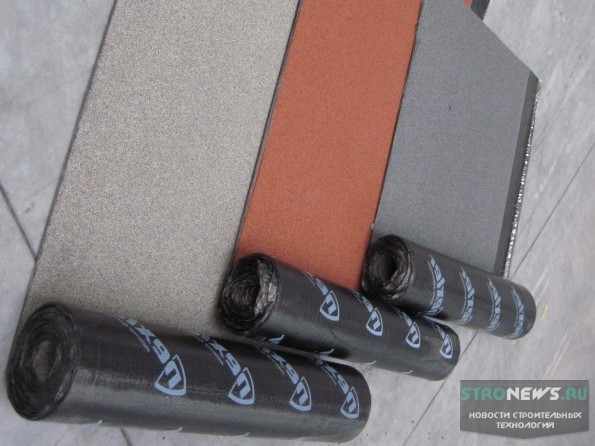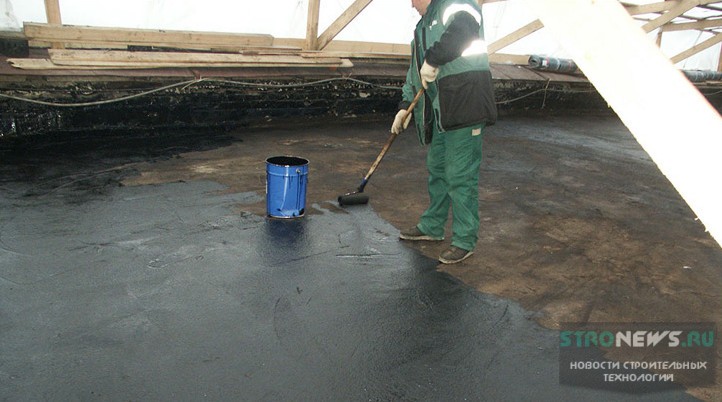How to lay roofing material on the roof?
Once very popular, roofing material is still used as a roofing material. And, although such a roof in its elegance cannot be compared, for example, with a metal tile coating, it has its undeniable trump cards - the simplicity of the coating process and the minimum costs required for this. How to lay a roof with roofing felt if you know all the features and sequence of its installation?
Types and properties of roofing material
Ruberoid is a plastic-based multilayer material: its cardboard base is covered with a binder bitumen-polymer coating, and a top layer is also applied on top, which performs not only decorative functions, but also provides sufficient abrasive strength.
This technology gives the roofing material the following positive properties:
- Ease of installation as the material comes in rolls that are easy to handle on the roof.
- Sufficient flexibility allows the use of roofing material with sudden changes in the configuration of the coating.
- The presence of a protective layer provides resistance to solar radiation.
- The material has excellent moisture resistance, water resistance and resistance to the accumulation of static electricity (the latter, by the way, cannot boast of the same metal tile).
At the same time, due to the presence of a cardboard base (even if with appropriate impregnation), the material does not have good mechanical strength, so in most cases it is laid in several layers. It is also worth noting the fire hazard of roofing material.
To answer the question - how to properly lay a roof with roofing felt, you must first understand the characteristics of the material.
Roofing material grade “K” is suitable for coating, and the following markings indicate the characteristics of the fractions of the external dressing:
- K - coarse-grained; it is used in the absence of sharp turns of the roof and roll bends. Suitable for flat roofs - sheds, outbuildings, etc.;
- M - fine-grained, is considered the most versatile and high-quality;
- P - scaly from mica; due to the increase in the weight of one linear meter, lightweight cardboard is used for the production of such roofing material, therefore its mechanical characteristics are somewhat lower.
For a multi-layer roof, roofing material of grade K is always taken as the top layer. In this case, the density of the material (the following marking numbers) should be maximum.

Also issued and euroroofing material. Since its thickness is greater, the number of laying layers can also be reduced. In addition, some brands of euroruberoid (from foreign manufacturers) have a surface ornament. This will not particularly affect the durability of the coating, but it will increase its aesthetic qualities. Worth mentioning and glass roofing material: appeared relatively recently, this roofing material is much less sensitive to external temperature changes.
The length of the roll of material according to GOST is 15 m. The standard sheet width is 1 m (with a possible plus tolerance of up to 25 ... 50 mm), but there are sheets with a width of 750 mm. Thus, it is not particularly difficult to calculate the consumption of roofing material for roofing.
How to lay roofing material on the roof
In budget options for its installation, roofing material is used mainly in the construction of country houses, built with the predominant use of wood. How to properly lay roofing material on a wooden roof?
The process begins with the following preparatory work:
- Alignment of the source material - the roll must be rolled out at least a day before the start of laying and let it mature. All work, by the way, must be performed in dry and moderately warm weather: at an air temperature of less than 10 0 C, the material may deform, and at temperatures above 30 0 C, the bituminous mastic that is part of the roofing material will begin to lose its high viscosity.
- Cleaning the original surface, removing protrusions and puttying depressions. The flooring should be primed using weatherproof compounds. All surface seams are especially carefully rubbed.
- Rolls of roofing material are cut according to the size of the roof. In this case, the minimum dimensions of the overlap of adjacent rolls are 100 ... 150 mm.
- Bituminous mastic is applied on completely dried flooring. It can be heated: the technology of application depends on the roofing felt recommended by the manufacturer for this brand. Check out information about .

We lay roofing felt on a wooden roof
The laying process should begin with lowered sections of the roof: overhangs, places for the subsequent placement of gutters, etc. At the same time, if the density of the roofing material exceeds 4 kg / running meter, then it is permissible to perform the laying in a single layer. The choice of laying direction - longitudinal or transverse - does not really matter.
Which side to lay the roofing material? At the ends of the coating the material must be laid with the topping up because otherwise the bonding quality will deteriorate. The same is done with the hot laying method, with the melting of the bituminous mastic. With multi-layer laying of roofing material in a cold way, laying with top dressing is obligatory only for the top layer: in this case, the conditions for natural ventilation of the coating improve. Each next layer of roofing material is laid with a shift of 150 ... 200 mm relative to the previous one.
To guarantee a uniform and tight adhesion, it is necessary that the bituminous adhesive protrudes beyond the surface of the roll by at least 5 mm during application. Its excess is removed with a sharp knife after the connection is complete.

There are a number of nuances in view of the fact that the roof will be horizontal:
- Filling the initial surface of the flooring is carried out by dissolving bitumen in a solution of gasoline, and all cracks, irregularities and gaps are poured with the finished composition. The primer layer should not be more than 50 mm;
- Only hot laying is used, and not only the roll itself is heated, but also the flooring;
- The roofing material is laid in two layers, with the second - in a direction perpendicular to the first. The top layer must be placed with the top layer up;
- The ends of the coating are additionally fixed with slate nails. For temperate climatic zones, the top coating can be smeared with bituminous mastic.
Watch the video on how to properly lay the roofing material on the roof:
 Masonry mortars for brick kilns
Masonry mortars for brick kilns Why do the windows fog up in the apartment
Why do the windows fog up in the apartment Construction and schemes of brick ovens
Construction and schemes of brick ovens How to lay paving slabs: tips and tricks
How to lay paving slabs: tips and tricks How to drill bathroom tiles
How to drill bathroom tiles Monolithic slab on coarse soil
Monolithic slab on coarse soil Which electric heater is economical
Which electric heater is economical